Text
On Reflection
Overall we thoroughly enjoyed this video essay assignment for the Professional Skills module.
The three of us worked particularly well as a group. Our method of working was organised and well structured, and our ability to co-operate with one another and communicate effectively throughout the entire process enabled us to fully realise our aim and objectives for this project.
Throughout the entire project the roles were shared and we each participated in all aspects of the process; from conception through to post-production. This even distribution ensured that no one person felt overwhelmed by what was asked of them.
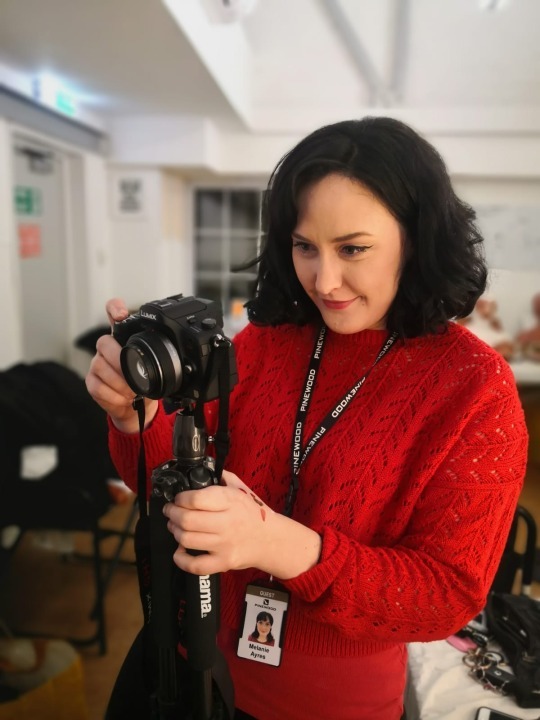
Figure 1. Sessions, 2020
The final images from the photoshoot were particularly effective and we were really pleased with them.
Overall we were happy with the appearance of our model in the photographs. The hair and make-up design we decided upon was effective and when combined with the costume and props, helped to convey a sense of timeless nostalgia in the image.
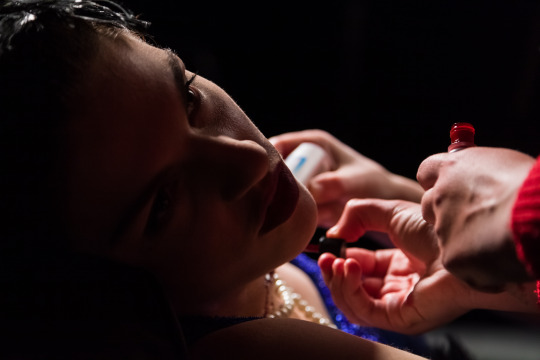
Figure 2. Lang, 2020
The prosthetic appliance was a mixed bag, however relatively successful given the circumstances. The piece was generic and hadn’t been sculpted on a life cast of our model and so it did not fit particularly well. We chose to position the area which fitted and blended the least well under the chin, with the hope that this could be disguised by strategic lighting and camera positioning.
This strategy was effective when looking at the final images, however close up and in the flesh it didn’t make for particularly comfortable viewing.

Figure 3. Lang, 2020
With regards to the video aspect of the project, we feel that overall this went well.
It maybe would’ve been preferable to have a more interesting background to our interviews, however we were limited to the room in which we shot the stills. In order to make it more visually appealing we dressed the corner of the room using a bust of (the Godfather of make-up) Dick Smith.
The questions we asked during the interview process primarily focused on our inspiration, the lighting design and creation of the mise-en-sene. By ensuring we all answered all of the interview questions, meant that we had enough footage to use in the edit however there were some points which we failed to discuss. To cover ourselves in the edit, Melanie later recorded some audio footage which contained the missing information which we were able to lay down over the visuals.
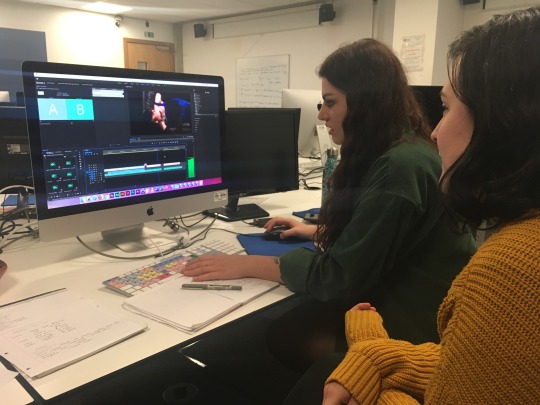
Figure 4. Sessions, 2020
Our choice of music to accompany the video was a particular success we felt. We initially chose three pieces of music to include in the video however this was reduced to two during the editing process.
We felt that the pieces of music we chose were not only in-keeping with the nostalgic theme of the film but also helped to reinforce the murder mystery feel we wanted to convey throughout.
Considering none of us had much/if any experience of editing video footage we were really pleased with the finished results.
Undertaking this video essay has ultimately been a thoroughly enjoyable experience. As previously mentioned, as a group we worked well together and by completing this project to the level which we feel we have achieved, reflects our ability to collaborate effectively.
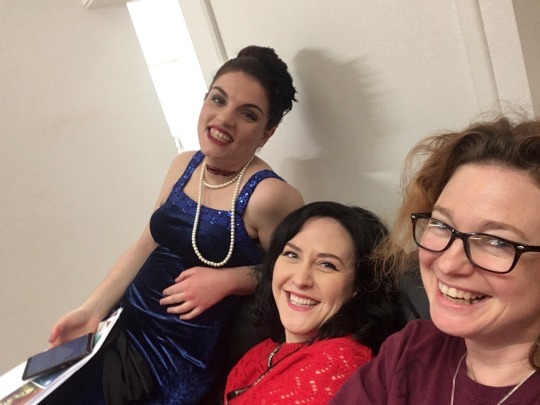
Figure 5. Sessions, 2020
References
Figure 1 - Sessions, L.J, (2020). Melanie [digital photograph]. Private collection
Figure 2 - Lang, S. (2020) Laura [digital photograph]. Private collection of LJS
Figure 3 - Lang, S. (2020) Refika [digital photograph]. Private collection of LJS
Figure 4 - Sessions, L.J. (2020) Edit [digital photograph]. Private collection
Figure 5 - Sessions, L.J. (2020) Just the three of us [digital photograph]. Private collection
0 notes
Text
Playing Dead

Below is the final version of our video essay, entitled Playing Dead (Sessions, Ayres & Salih, 2020).
vimeo
The video has been uploaded onto online video platform Vimeo.
The direct link can be found here: https://vimeo.com/402660648
Should the video require a password, please use the Professional Skills module number AD714.
References
Ayres, M, Sessions, L,J and Salih, R. (2020) Playing Dead [video] Private collection
0 notes
Text
Putting The Pieces Together
On completion of the photographic and interview shoots, we entered the post production stage.
For the purposes of this video essay we used the Adobe editing software Premiere.
We began the editing process by going though all the footage we had accumulated over the course of the shoot; taking into account the footage from the photographic shoot day, the interviews and the stills shots taken throughout the process. We recorded the time codes from each piece of footage and noted which parts of the footage contained the information we wanted to use.
Once we had worked our way though the footage we grouped the interviews by question. By organising the interviews this way were were able to ascertain which responses best answered that particular question.
We chose the best responses to each question and then cut that piece of footage down so it contained only the relevant information. The video track was then moved down onto the timeline.
Once we had assembled the interview footage along the timeline we organised the clips into the order in which we wanted them.
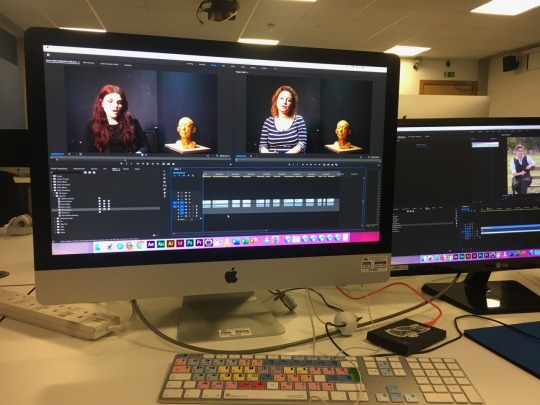
Fig. 1 Sessions, 2020
Working methodically we then discussed where we wanted to overlay the interviews with stills or video clips and which to include.
We chose a selection of images and video footage from the production process which we felt was most relevant to the content of the audio from the interviews. We made a note of the order in which we were laying down the footage and the additional material so we could ensure we have all the content we needed.
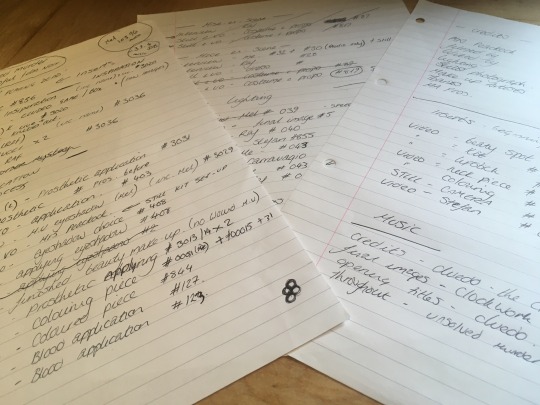
Fig 2. (Sessions, 2020)
Wanting to complete the visual elements of the video before we focused on additional audio content we also complied the titles and end credits.

Fig 3. (Sessions, 2020)
Once the visual track was complete we moved on to the audio tracks. The audio track from the interviews was already complete so it was a question of adding music to the opening and closing titles and any additional video footage.
We decided to use music which was in keeping with the feel of the character and also the genre of the piece. We chose a small number of instrumental pieces of music which we felt worked well with the overall theme.
The music was laid down onto the timeline and the audio levels were adjusted accordingly.
One of the pieces of music we included was the main theme to the board game Cluedo (below).
youtube
Once we had completed the edit we backed up the video on two different devices so as to ensure that the footage was not lost.
References
Fig 1. Sessions, L,J. (2020). Editing 1 [digital photograph]. Private collection
Fig. 2 Sessions, L,J. (2020). Edit Notes [digital photograph]. Private collection
Fig. 3 Sessions, L,J. (2020). Editing 2 [digital photograph]. Private collection
Unknown, (2018). Clue/Cluedo: The Classic Mystery Game [theme tune]. Accessed on 12 March 202. Available from: https://www.youtube.com/watch?v=CbO14kV0MI0
0 notes
Text
Called in for Questioning
To give our video essay some additional content, we decided to film some interviews of the three of us talking about the pre-production and planing process.
In preparation for the interviews we found a space in which to film (a store room at CMS) and dressed it in order to provide a more visually pleasing and appropriate setting.
The room was painted black and we dressed it using a black director style chair and a sculpting table, upon which we placed a head cast of Special Effects Make-up Artist Dick Smith (1922-1914). The latter detail we decided was particularly relevant given our subject area of study and would help provide context.
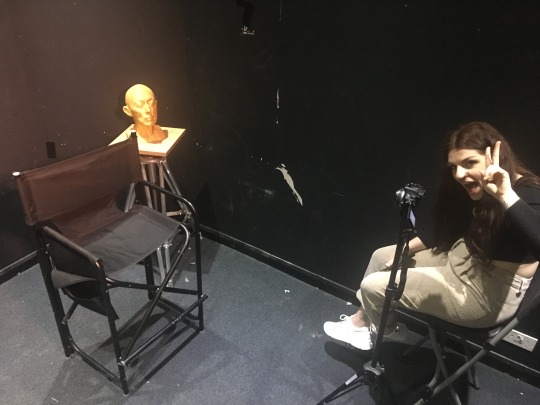
Fig. 1 (Sessions, 2020)
We used a Panasonic Lumix DMC-GH1 to record the interviews and lit the set using a single light source.
The light was positioned slightly off centre (camera left), ensuring that the face was clearly lit and that there was a catchlight in the eyes of the interviewee.
We positioned the interviewer to the right of the camera (and made sure that the image was sharp). Below is the reverse image taken from the post of view of the interviewee.

Fig. 2 (Sessions, 2020)
We had discussed and agreed upon a series of questions which we all took turns in answering. We decided to all answer the same questions so that we would have more content to choose from in the final edit.
The questions we asked were as follows:
What was the initial inspiration for the character?
How did the make-up deign reflect our character idea?
How did the lighting help create mise-en-scene?
How did the lighting design emphasise the texture of the prosthetic piece?
What was the inspiration for the lighting design?
We wrote open ended questions which required us to give a full response. We tried to ensure that when we answered the questions we began by repeating the question back to the interviewer.
Our research suggested that the audio recording of voices should peak around -12 and so we set the recording level accordingly to ensure the audio remained balanced throughout.
References
Fig. 1 Sessions, L, J. (2020). Behind the scenes 1. [digital image]. Private collection
Fig. 2 Sessions, L, J. (2020). Behind the scenes 2. [digital image]. Private collection
0 notes
Text
Forensic Photography
We received the final images from the photoshoot and selected a number of images which we as a group felt best achieved our objective.
Below are the images we selected.
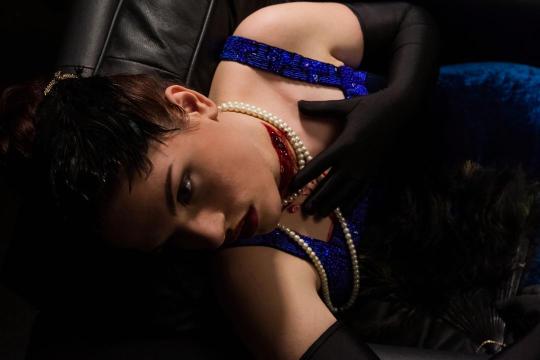
Fig 1. (Lang, 2020)
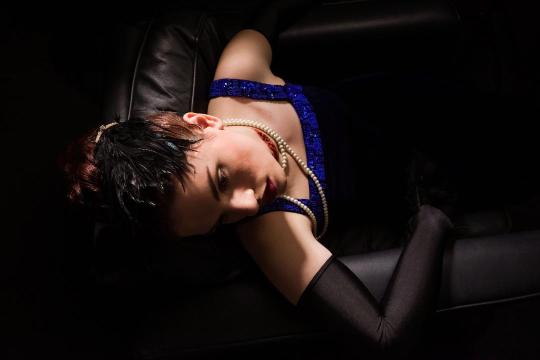
Fig. 2 (Lang, 2020)
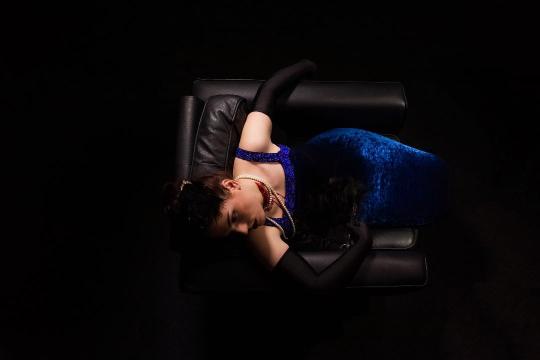
Fig 3. (Lang, 2020)
References
Fig. 1 Lang, S. (2020), Final Image 1 [digital photograph], Private Collection
Fig. 2 Lang, S. (2020), Final Image 2 [digital photograph], Private Collection
Fig. 3 Lang, S. (2020), Final Image 3 [digital photograph], Private Collection
0 notes
Text
The Scene of the Crime
We discussed with the Photographer Stefan Lang the lighting requirements for the scene. We wanted the light to be low-key with a focused pool of light on the neck, face and chest of our model.
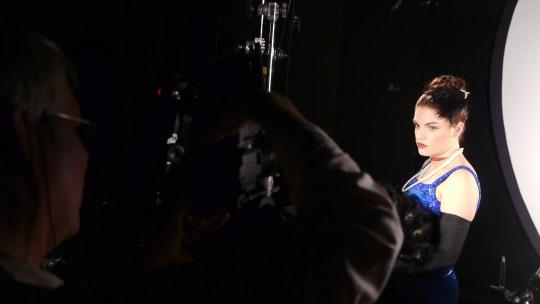
Fig. 1 (Sessions, 2020)
This particular lighting set up was inspired by some of our reference material (mentioned in a previous post - In the Library) but also by the work of Italian painter Michelangelo Merisi da Caravaggio (1571-1610).
Caravaggio was known for his use of chiaroscuro; strong contrasts between light and dark. This use of light helped him to achieve a three-dimensional depth to his paintings.
The painting Judith Beheading Holofernes (1599) played an influential part in our decision making process with regards to positioning and lighting.

Fig. 2 (Caravaggio, 1598-1599)
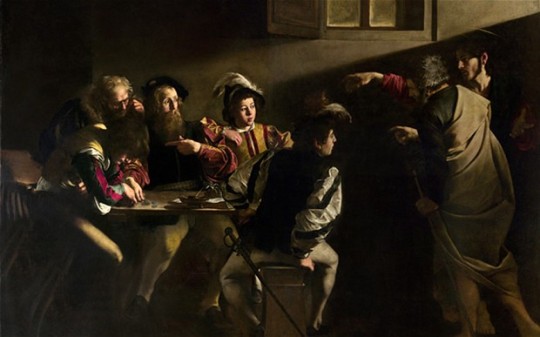
Fig. 3 (Caravaggio, 1599-1600)
We decided to keep the space visually neutral. The room we were shooting in was black and so we decided to use this to our advantage. The darkness surrounding the model means there is nothing to distract from the focal point of the image; it also allows the setting to appear vague, meaning the viewer can use their own imagine to create the setting.
We decided to position the model in a chair and found a black leather effect chair which would blend in well with the black background.
We also discussed the angle from which to take the photograph and framed up the image from various angles using an iPhone. We considered a number of angles including those in the images below.

Fig. 4 (Sessions, 2020)

Fig. 5 (Sessions, 2020)
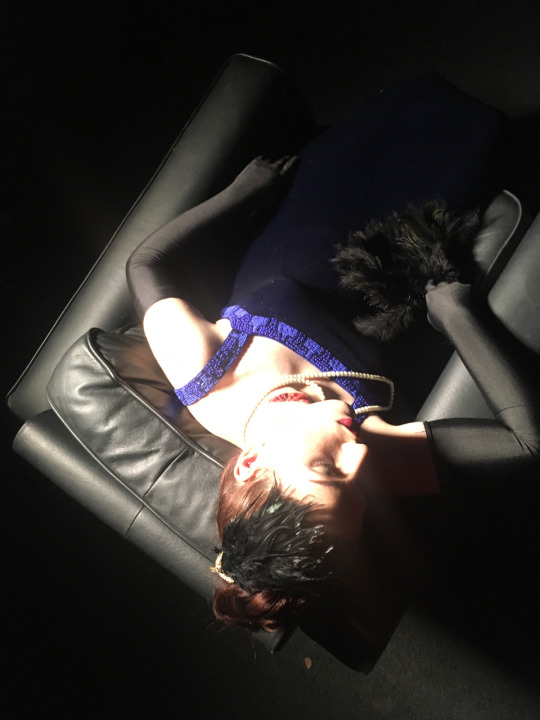
Fig. 6 (Sessions, 2020)
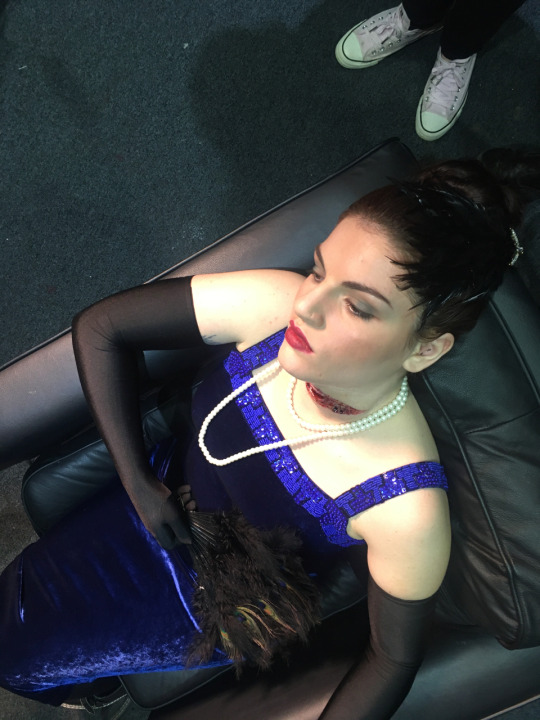
Fig. 7 (Sessions, 2020)
We positioned the model slumped in a chair with her head tilted back and off to the side as if she had been attacked from behind.
We decided to take the photograph from overhead. By taking the photograph from this angle and lighting the image as we planned, the viewers eye would be drawn to the neck and the prosthetic piece.
The image below is one of the final images which gives a better idea as to the final angle.
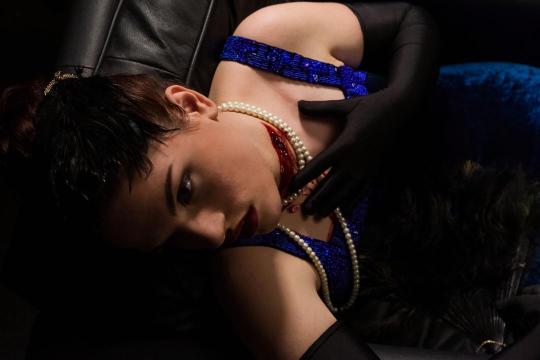
Fig. 8 (Lang, 2020)
References
Fig. 1 Sessions, L, J. (2020) Behind The Scenes. [digital photograph]. Private collection
Fig. 2 Caravaggio, M. (1598 - 1599) Judith Beheading Holofernes. [painting] Rome: Galleria Nazionale d'Arte Antica
Fig. 3 Caravaggio, M. (1599-1600) Chiamata di San Matteo. [painting] Rome: San Luigi dei Francesi
Fig. 4 Sessions, L, J. (2020) Test Angle 1. [digital photograph]. Private collection
Fig. 5 Sessions, L, J. (2020) Test angle 2. [digital photograph]. Private collection
Fig. 6 Sessions, L, J. (2020) Test Angle 3. [digital photograph]. Private collection
Fig. 7 Sessions, L, J. (2020) Test Angles 4. [digital photograph]. Private collection
Fig. 8 Lang, S. (2020) Test Angle 5 [digital photograph]. Private collection
0 notes
Text
With The Dagger
The creation of a murder and a crime scene inevitably involves a murder weapon.
In the board game Cluedo, there are a number of possible murder weapons:
Candlestick
Dagger
Lead Pipe
Revolver
Rope
Wrench

Fig. 1 (Anon, date unknown)
Our choice of murder weapon was very much dependant upon the prosthetic pieces which were available to us for the shoot.
After looking at the pieces which were available for us to use for this project, we decided upon a silicone appliance which was sculpted to appear like a ‘slit throat’. With this in mind we decided to use a dagger (knife) as the murder weapon in our own scene.
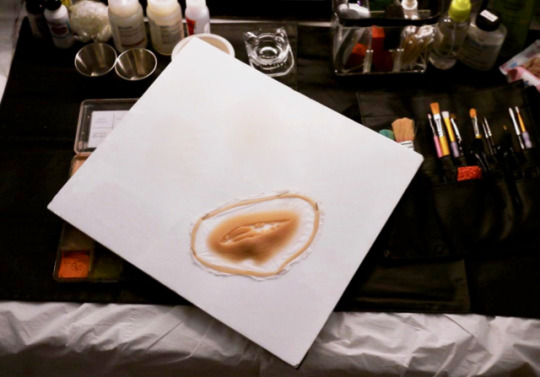
Fig. 2 (Sessions, 2020)
Unfortunately the piece wasn’t designed specifically for our model and so it wasn’t the perfect fit, which meant that it didn’t sit particularly well under the chin. We made a note to take this into consideration when positioning the model and lighting the scene.
We sourced a kitchen knife which we felt would be large enough to create the wound and remain believable as a murder weapon. Another consideration was how it would appear in the final image.
We then looked at films which feature a knife as the murder weapon. These included: Psycho (Hitchcock, 1960), Primal Fear (Hoblit, 1996) Carrie (De palma, 1976), and Halloween (Carpenter, 1978).
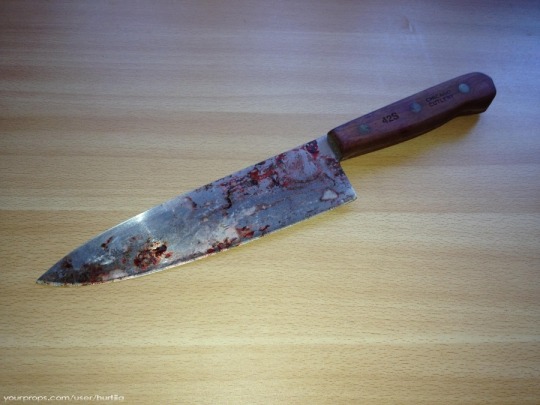
Fig. 3 (Yourprops.com, date unknown)
The image (above) is the Butcher Knife used by Aaron Stampler (Edward Norton) in order to stab the Archbishop (seventy eight times) in Primal Fear (Hoblit, 1996).
Perhaps one of the most famous murder scenes involving a knife and arguably one of the most famous film scenes of all time is the shower scene in Psycho (Hitchcock, 1960)
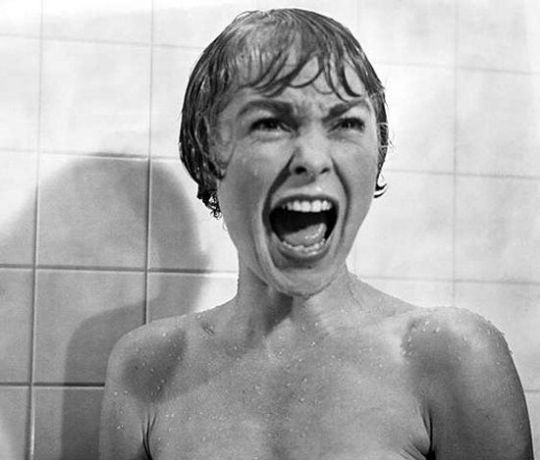
Fig. 4 (Hitchcock, 1960)
Whilst not the murder weapon in the film, the use of a knife brought us neatly full circle to one of our original sources of reference - Knives Out (Johnson, 2019).

Fig. 5 (Johnson, 2019)
References
Fig. 1 Anon. (date unknown). Cluedo Murder Weapons [online photograph], Accessed via: https://www.tripadvisor.com/LocationPhotoDirectLink-g60954-d3292036-i260245750-Salem_Smugglers_Tour-Salem_Massachusetts.html
Fig. 2 Sessions, L. (2020). Slit Throat Appliance [photograph]
Fig. 3 Yourprops.com. (date unknown). Primal Fear, Murder Weapon [Accessed on: 11 March 2020]. Available: https://www.yourprops.com/Murder-Weapon-original-movie-prop-Primal-Fear-1996-YP56375.html
Fig 4. Hitchcock, A. (1960). Psycho. [film]. United States, Shamley Productions
Fig. 5 Johnston, R. (2019). Knives Out [film still].
0 notes
Text
In The Library
In preparation for the shoot, we researched not only the character we were creating but also the way we wanted the scene to appear in terms of lighting and mise-en-scene.
As this was a stills shoot we specifically looked for existing images which contained low key and focused lighting which draws the viewers eye to a particular part of the image.
Knives out
The artwork for the 2019 movie Knives Out (Johnson, 2019) staring Daniel Craig.
Renowned crime novelist Harlan Thrombey is found dead following his 85th birthday celebrations. With his family and household staff all under suspicion, Detective Benoit Blanc is mysteriously called in investigate in this modern whodunit.
The lighting in these images is high contrast, with quite a high colour saturation.

Fig. 1 (Johnson, 2019)
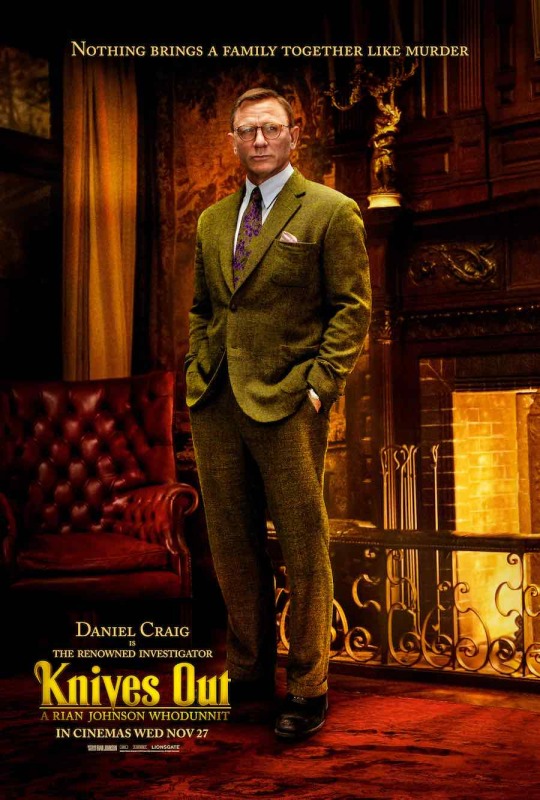
Fig. 2 (Johnson, 2019)
Gucci
The 2012 Fall Campaign by Gucci.
These seemingly murder mystery inspired images were photographed by Mert & Marcus.
The lighting is low-key. The strong back light creates rim of light on shoulder and hair of the model.

Fig. 3 (Mert & Marcus, 2012)

Fig. 4 (Mert & Marcus 2012)
Melanie Pullen
Our final key source of reference was High Fashion Crime Scenes (2003-2017), a series of images by LA based photographer Melanie Pullen.
Based on vintage crime-scene images and details from the files of The Los Angeles Police Department and The LA County Coroner’s Office, the series depicts the victims in a variety of elaborately staged settings.
I began recreating crime scene photos for many reasons, but one of them is that in all their darkness, they’re a completed story – each a perfect photograph, a still shot that captures the final moment and if you look closely enough, always tell a tale. I think this is why so many photographers became fascinated with the subject in the 1940s and 50s. (Pullen, 2007)
Pullen focuses on the dehumanisation of sex and violence and confronts society’s glamorization of violent acts of crime. The images are gitty and dark; victims (many recognised models and actresses) are elegantly dressed in haute-couture clothing and are placed in environments out of context with the glamorous persona.
In order to help create a sense of atmosphere and mise-en-sense, Pullen incorporated lighting effects usually seen in film and worked with professional cinematographers for advice on creating her settings and realising her ideas.
The High Fashion Crime Scenes (2003-2017) rely on the lighting appearing like the scene is lit purely by the obvious sources - in the case of the image above, lit from overhead by street lamps.
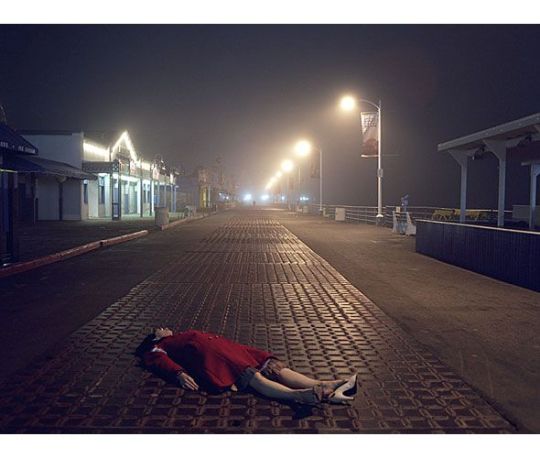
Fig. 5 (Pullen, 2007)
youtube
Segell, 2005
Guy Bourdin
French photographer Guy Bourdin frequently objectified the female form in his images and made them appear almost like mannequins.
He used high contrast lighting techniques to produce images with high colour saturation. The use of the colour red prominent in his work.
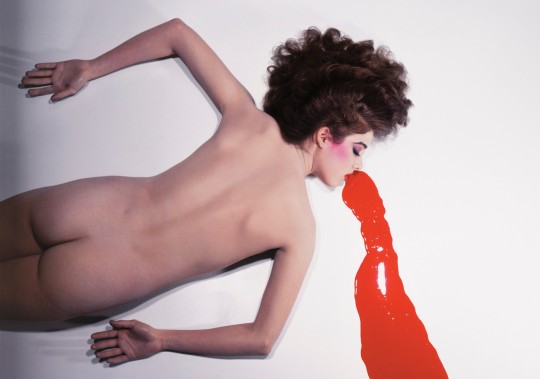
Fig. 6. (Bourdin, 1980)
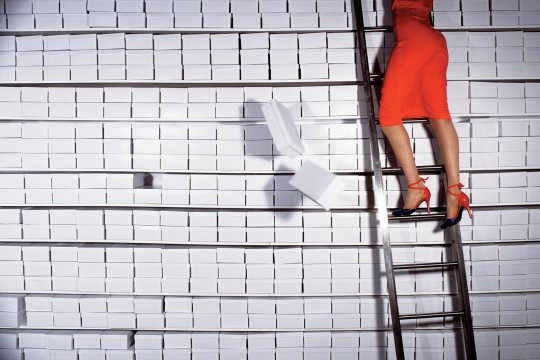
Fig. 7 (Bourdin, 1977)
References
Fig. 1 Knives Out. (2019), Poster, [5 March 2020]. Available from: https://collider.com/knives-out-cast-character-posters/
Fig. 2 Knives Out. (2019), Poster, [5 March 2020]. Available from: https://www.seenit.co.uk/daniel-craig-and-chris-evans-knives-out-gets-new-posters/
Fig. 3 Mert & Marcus. (2012) Gucci Fall 2012.
Fig. 4 Mert & Marcus. (2012) Gucci Fall 2012.
Fig. 5 Pullen, M. (2007). High Fashion Crime Scenes
Fig. 6 Bourdin, G. (1980). Pentax calendar
Fig. 7 Bourdin, G. (1977). Charles Jourdan, Fall 1977.
Pullen, M. (2007). Melanie Pullen: High Fashion Crime Scenes. Interviewed by Micamera Lens Based Art, 18th September 2007. Available at: http://www.micamera.it/portfolio/melanie-pullen-high-fashion-crime-scenes/?lang=en
Segell, E. (2005). Distractions: Melanie Pullen, [online], Available online at: https://www.youtube.com/watch?v=pF9tKM1BRrA&feature=youtu.be [Accessed: 5th March 2020].
0 notes
Text
Mrs Peacock
With our concept in place, we researched material which could help us develop our design and inform our decision making.
Working within the perimeters of the characters and murder weapons from the board game Cluedo, we decided to create our own interpretation of the character Mrs Peacock (the blue counter).
We looked at various incarnations of Mrs Peacock. The images below (figure 1) are previous depictions of the Mrs Peacock character card.
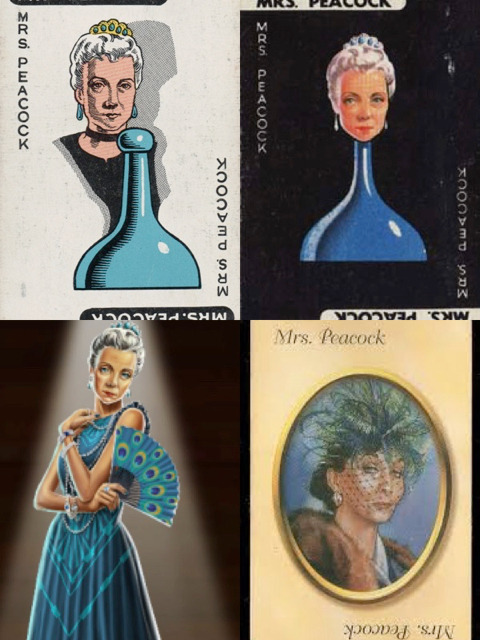
Figure 1. Hasbro, date unknown
Mrs Peacock has also been portrayed on both television and film (figure 2)

Figure 2. Clockwise from top left: Joanna Lumley (The Word, the Flesh and the Devil), Rula Lenska (Cluedo), Kate O’Mara (Cluedo), Eileen Brennan (Clue)
In the classic version of the game, Mrs Peacock is portrayed as the Grande-Dame (figure 3).

Figure 3. Hasbro, date unknown
In the current version of the board game, Mrs Peacock is portrayed as a much younger character (figure 4).
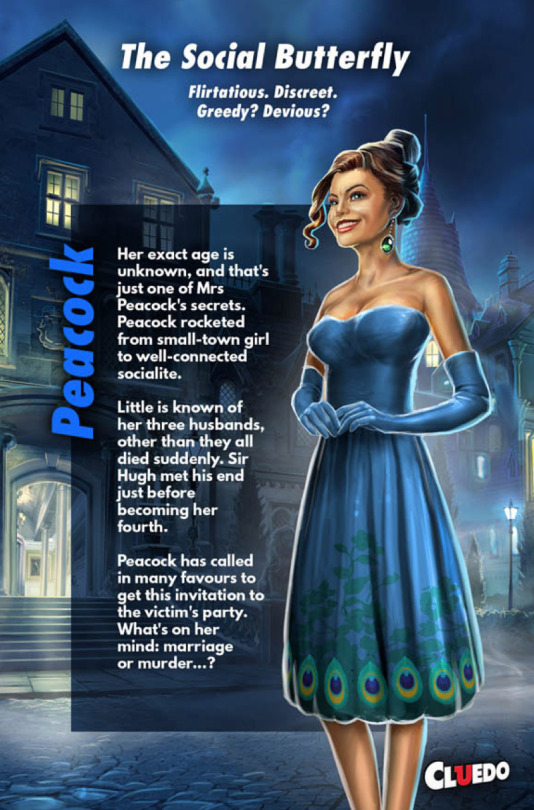
Figure 4. Hasbro, date unknown
Our own interpretation of Mrs Peacock will also depict her as a younger character.
Throughout all versions and interpretations of the game (filmic or otherwise), Mrs Peacock character is portrayed as an elegant and wealthy woman. She moves within high society and is possibly also a woman of influence. In order to ensure that we can convey these traits in one image it is important that we dress our Mrs Peacock appropriately.
Costume
We wanted the final image of our character to have a timeless feel to it. We wanted the costume and make-up to hint at a decade past however not conform to the trends of a specific period in time.
We have sourced a blue dress in a crushed faux-velvet fabric; it’s design is elegant and sophisticated. The richness of the fabric helps to convey her wealth and helps to signify the social circles she moves in.
Most of the previous incarnations (in print and on screen) are dressed in blue which we feel is integral to her character design. By dressing our model in blue, we are reinforcing her colour identity in the game.
In order to reinforce her identity, we have also sourced a peacock feather fan which acts as as signifier towards her name.

Figure 5. Salih, 2020
Make-up & Hair Design
In addition to the costume, we have also considered the styling of the make-up and hair. We created a make-up face chart (figure 5) to help us realise our final look.
As we are creating a character from no specific period in time but with a particularly nostalgic feel, we decided that creating an ‘up do’ with the models hair would be most believable for our character. We opted for an elegant bun on the top of her head and to add a little interest we will use a feather hair accessory.
The make-up will again be sophisticated and elegant. We are planning on using a blue eyeshadow and combining this with a red lip.
The prosthetic appliance we had chosen was sculpted to give the appearance of a slit throat. Unfortunately the piece was little large for our models neck so we will have to make allowances for this during application.
On the day of the shoot we will colour the piece using alcohol based paints to create the effect of blood and fatty tissue.
References
Figure 1:
Pratt, A, E. Cluedo. Birmingham. 1943, United States, Hasbro. Board Game
Figure 2:
Howson, J. (1991), Cluedo. [TV Series], United Kingdom, Granada Television
Jarrold, J. (1993) The Word, the Flesh and the Devil [Game Show] UK, Action Time
Lynn, J. (1995), Clue. [film] United States, Paramount Pictures
Figure 3:
Pratt, A, E. Cluedo. Birmingham. 1943, United States, Hasbro. Board Game
Figure 4:
Pratt, A, E. Cluedo. Birmingham. 1943, United States, Hasbro. Board Game
Figure 5:
Salih, R, (2020), Face Chart, Personal collection
1 note
·
View note
Text
Murder Most Horrid
From the launch of the assignment we knew that we wanted to create a scene from a murder-mystery and ideally one which would envoke a sense of nostalgia.
Initially we considered a crime scene complete with a chalk outline of a body. A Chalk outline is a temporary outline drawn onto the ground which outlines evidence found at the scene of a crime. Although not used in contemporary investigations (for fear of contaminating a scene of crime), they are synonymous with screen crime scenes within the murder mystery genre in literature and film.
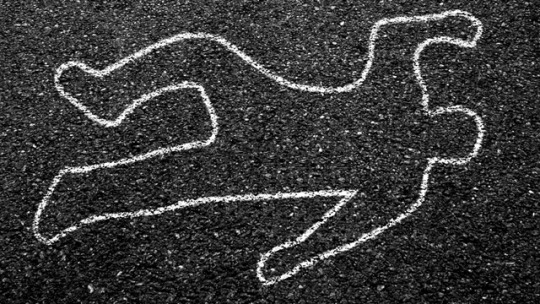
Fig. 1 (Christie, 1942)
The first mystery series to feature chalk or tape outlines to mark the spots where bodies were found (Unknown)��was in a 1958 episode of Perry Mason "The Case of the Perjured Parrot" (Russell, 1958).
In most cases of chalk outlines, the body isn't actually seen, consequently this put pay to our initial idea!
Keeping with the murder mystery theme, we came up with the idea of creating a scene along the lines of "The Body In The Library" (1942), the Agatha Christie novel in which the body of a young woman is discovered in the library of a stately home. Miss Marple elderly spinster and amateur consulting detective is called in to investigate...
Developing this theme further we hit upon the idea of devising a scene from the board game Cluedo.
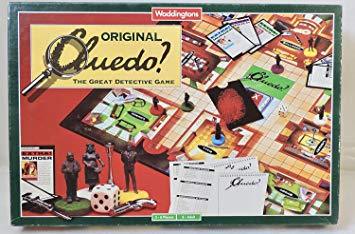
Fig. 2 (Pratt, 1943)
Cluedo is a murder mystery game devised in Birmingham in 1943 by Anthony E. Pratt.
A body (Mr Black) has been found and the object of the game is to determine three things: who murdered the game's victim, where the crime took place and which weapon was used. Players assume the role of one of six characters (each of whom are suspects) and work their way strategically around the board which is laid out to represent rooms in a mansion. Each collecting clues about the murder.
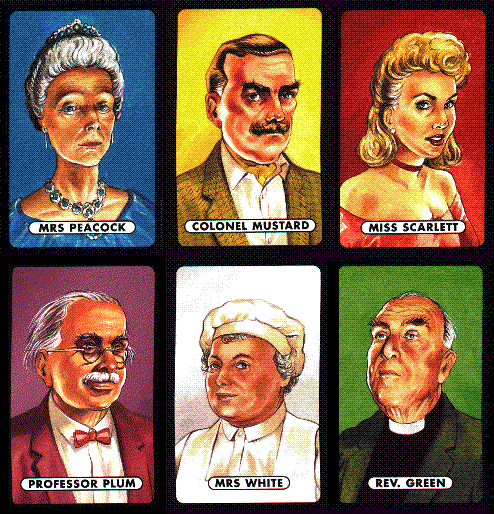
Fig. 3 (Pratt, 1943)
The characters/suspects in the game are:
Miss Scarlett - red
Rev. Green - green
Colonel Mustard - yellow
Professor Plum - purple
Mrs. Peacock - blue
Mrs. White - white
In 2016 Hasbro launched the current standard version of the game with the first new original character in over 67 years: Dr. Orchid, replacing Mrs White.
As with the suspects, there are a number of murder weapons which could have been used to kill Mr Black.
Candlestick
Dagger
Lead Pipe
Revolver
Rope
Wrench
As a group we decided to create a crime scene using one of the characters and one of the weapons from the board game.
Below is a film still from Clue (Lynn) the 1985 film adaptation of the game.
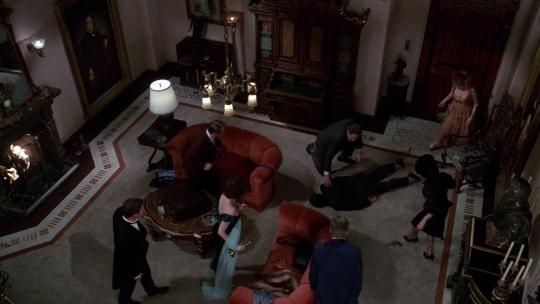
Fig. 4 (Lynn, 1985)
References
Fig. 1 Christie, A. (1942). The Body In The Library, Glasgow, Collins.
Fig. 2 Pratt, A, E. Cluedo. Birmingham. 1943, United States, Hasbro [Board Game]
Fig. 3 Pratt, A, E. Cluedo. Birmingham. 1943, United States, Hasbro [picture cards
Fig. 4 Lynn, J. (1995), Clue. [film] United States, Paramount Pictures
Perry Mason: The Case of the Perjured Parrot. (1958), CBS Television Network, 20 Dec 1958, Unknown. The TVDB. [online] Available at: https://www.thetvdb.com/series/perry-mason: [Accessed Date: 4 March 202]
0 notes
Text
The Plot
The objective of this assignment for our Professional Skills module is to produce a 4-5 minute video essay.
Working in groups of three, we are to plan for and execute a photographic shoot and then produce a video which documents the process and showcases our knowledge of lighting and camera work with particular emphasis on shooting prosthetic pieces.
Through this assignment the aim is to:
Design a character as a group
Evaluate the process of how lighting and camera affects characters
Develop an understanding of mise-en-scene
Develop basic technical knowledge of camera and lighting
Develop base level understanding of video editing (using Premier)
Deliver a video essay
Within the group we will cover key roles throughout the production process, including:
Pre-production: Researcher, lighting Designer,
Production: Camera Operator, Gaffer, Makeup artist, Spark, photographer,
Post-production: Editor, Sound Engineer
During the post-production process we will edit our video footage and combine it with a variety of other material including voice-overs, interviews and stills images in order to realise our finished film.
0 notes